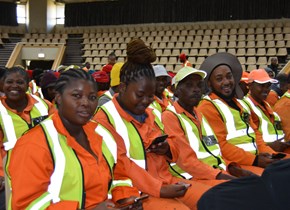With all the different types of workplace training that are available, it is easy to become confused about the various concepts and what each one entails. The aim of workplace training is to enable a person to acquire knowledge, skills and competencies, with the specific goal of improving one’s work performance. Various forms of workplace training are available, and there are services suited to almost every jobseeker, whatever his/her interests or level of skill.
The following serve as a guide to employee training opportunities:
This can be regarded as the guided exposure of students to real-world experiences that are integrated with classroom-based curricula, and that focuses on the creation of knowledge through the transformation of experience.
This is an educational programme of applied learning in the workplace that involves achievable and credit-bearing learning outcomes; structured, monitored and assessed to ensure integration with the curriculum outcomes of the qualification as a whole.
Students are encouraged to learn through the structured exploration of a research or practice-based problem. This is a form of interdisciplinary learning, where students work in groups to complete tasks designed to define, process and reflect on real-life problems. The lecturer acts as curriculum
co-ordinator or research facilitator.
This combines problem-based learning and workplace learning, integrating intellectual inquiry, real-world problems and student engagement in a relevant and meaningful way. Project work is generally understood to facilitate students’ understanding of essential concepts and practical skills.
This is a credit-bearing educational experience, where students participate in reciprocal and organised service activities that meet identified community needs, with reflection by students being critical for an enhanced understanding of the curriculum, and thus a proper sense of civic responsibility.
Practical experience (at a professional practice) is integrated into the formal learning programme, with the workplace serving as a learning resource and benchmark of practice. Workplace learning is common in the health professions.
An internship is a type of temporary, hands-on experience, where interns gain the relevant knowledge and skills necessary for employment in a specific career field. Internships may be paid, unpaid or partially paid, and benefit both the prospective employee and the employer. In some cases, the intern is employed by the company upon completion of his/her studies, since he/she typically requires little or no training.
A learnership, which is composed of unit standards, is a work-based approach to learning and obtaining a qualification. It includes both structured work experience (practical work) and theory. A learnership is a means of obtaining a qualification that is directly related to the work being done, and affords you the opportunity to study further, or to be promoted.
Volunteer work is any type of service that is rendered free of charge. Volunteers donate their time and talent to a cause, or for a purpose they support, and can choose how often and when they wish to do so. Doing volunteer work can be a positive factor when it comes to securing a job, especially when it is connected to a specific field.
This is a system of training a new generation of practitioners in a structured, competency-based set of skills. Apprenticeships range from craft occupations or trades, to professional licences, to practising in regulated professions. Most of the training takes place while apprentices work for an employer, who helps these apprentices to learn a trade or profession in exchange for services for a set period of time following the achievement of measurable competencies.
References
- Kolb, D.A. 1984. Experiential learning. Englewood Cliffs, NJ: Prentice-Hall, Inc.
- UFS (University of the Free State). 2006. Community service policy. Bloemfontein: UFS.
- Forbes, B.E. 2006. Programme design and quality management for work-integrated learning in a cooperative education partnership. Paper presented at the SASCE Conference on Cooperative Education and Work-Integrated Learning. Vereeniging, South Africa, 17-19 September 2006.
- Engel-Hills, P., Garraway, J., Jacobs, C., Volbrecht, T. & Winberg, C. 2010. Working for a degree: Work-integrated learning in the higher education qualifications framework. In: R. Townsend (Ed.). Kagisano No. 7: Universities of Technology – Deepening the Debate. Pretoria: Council on Higher Education.
- Ori, S. 2008. Work-integrated learning: The DUT experience. Paper presented at the Researching Work and Learning Breakfast. Durban, South Africa, 22 August 2008.
- Engel-Hills, P., Garraway, J., Jacobs, C., Volbrecht, T. & Winberg, C. 2010. Work-integrated learning (WIL) and the HEQF. Paper presented at the NQF Research Conference, Johannesburg, South Africa, 2-4 June 2010.
- https://www.ehow.com
- https://www.differencebetween.net
- https://www.brighthub.com
- https://www.thecareersportal.co.za
- https://www.lmiworks.nl.ca

Prof. Deon de Beer – NRF SARChI Chair in Medical Product Development through Additive Manufacturing
CUT News CRPMDeon’s career started at NECSA (1979), which stimulated his research interest. This led to 35 years in...

CUT engineering students showcase innovative designs incorporating new techniques and modern technology
CUT News ideaGYMPictured: The top three winning designs demonstrated creativity, originality, uniqueness, functionality,...

Pothole Eradication Programme aimed at improving road safety and quality in the province
CUT News Community EngagementLearners excited to receive certifications, as they start the next part of the training and skills programme.The...